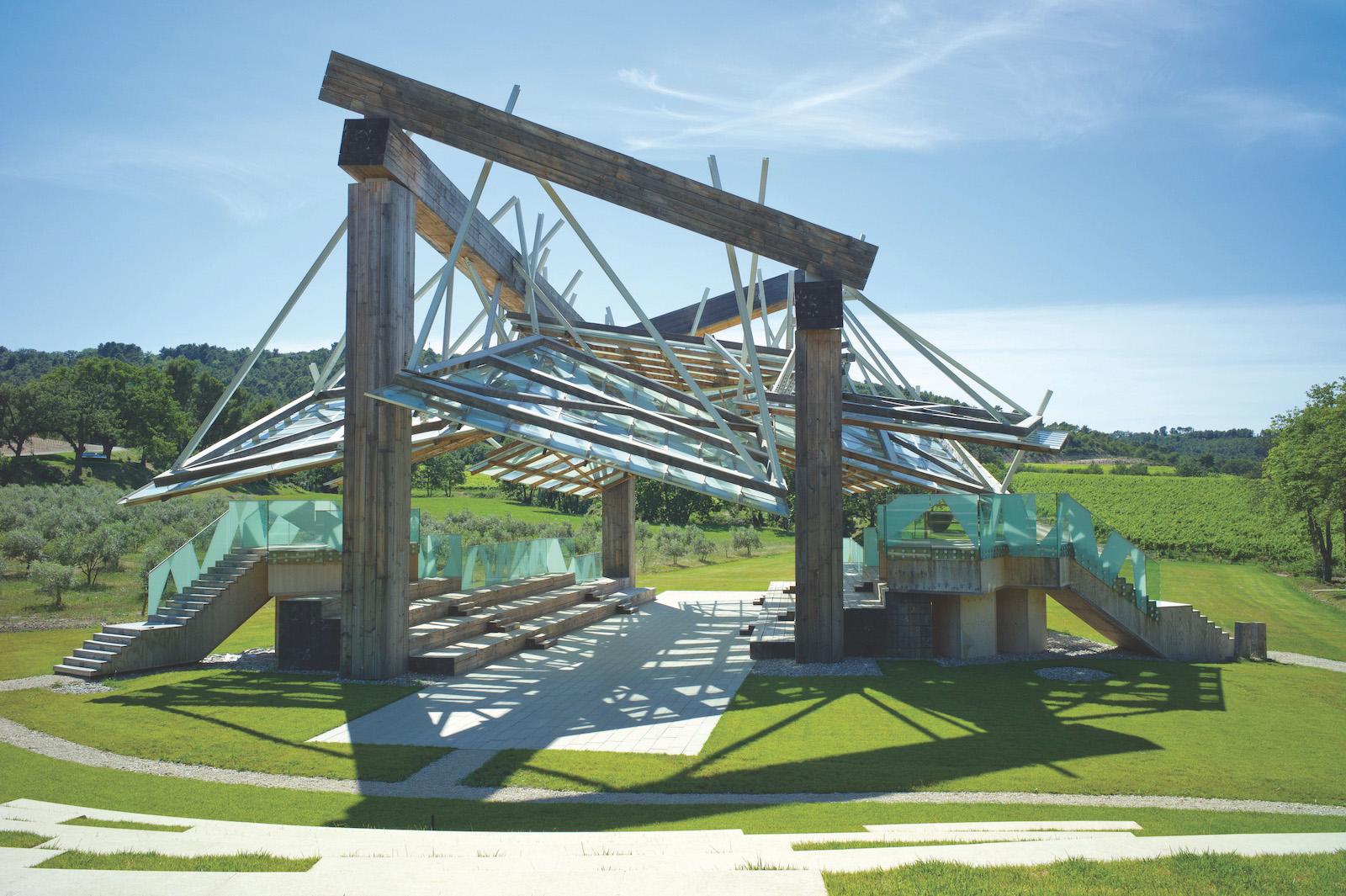
Because of its natural associations with creativity, craftsmanship, and pleasure, wine has long been closely aligned with art and consumers often expect to pay good money to enjoy both. While much of the world continues to open up to international tourism in 2022, many wineries have homed in on different ways they can continue integrating art into the experiences they offer visitors.
Some have built intimate galleries in their cellars to showcase the works of local artists, some have commissioned large-scale sculptures throughout their properties, and others regularly invite international artists to design immersive installations near their vineyards. Wine has historically taken center stage in this pairing, but the following ten wineries—from Northern California to South Africa, the North Island of New Zealand to the south of France—all foreground art as a crucial aspect of their identities.
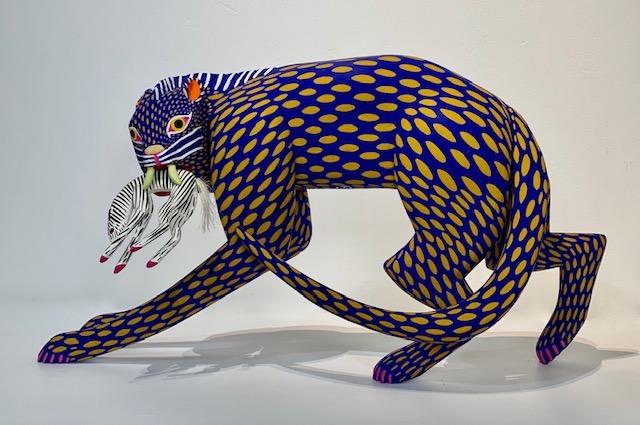
Sculpture from the Brander Museum of Folk Art collection.
Fred Brander is the third-generation winemaker at Brander Vineyards in California’s Santa Ynez Valley. As he began to put his own stamp on the family business, Fred saw an opportunity to both distinguish the vineyard’s Sauvignon Blanc from other plantings in the region and to bring his personal collection of Mexican ceramics to a broader audience. This collection has grown into the Brander Museum of Folk Art, an intimate and inviting center for Latin American—and specifically Mexican—craft.
The Museum forges close connections between art and wine, viewing them both as expressions of passion, work, and community. Regularly-rotating exhibitions encourage visitors to explore the embeddedness of cultural production within practice and place emphasis on the context and history behind the many objects on display.
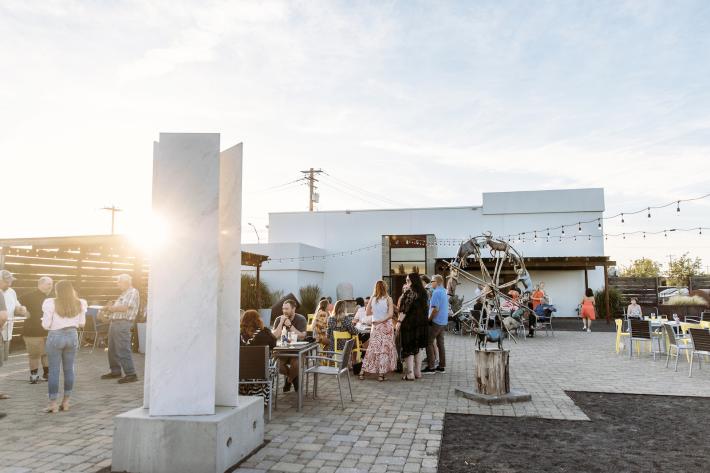
View of Foundry Vineyards.
Foundry first emerged as an actual foundry where, in 1980, owners Mark and Patty Anderson collaborated with renowned artists such as Jim Dine to bring large-scale sculptural works to life. With grape plantings dating back only to 1998, this winery just outside of downtown Walla Walla has since solidified its dedication to the arts. Foundry Vineyards now produces exciting organic wines and hosts visitors in its sleek yet warm gallery and tasting room spaces both in Walla Walla and downtown Seattle.
In Walla Walla, Foundry’s property includes a sculpture garden and patio, while inside, there are quarterly exhibitions featuring the works of international artists in a variety of media. Foundry has helped cultivate an inviting and cosmopolitan blend of world-class art and experimental wine in this already-innovative area of Washington wine country.
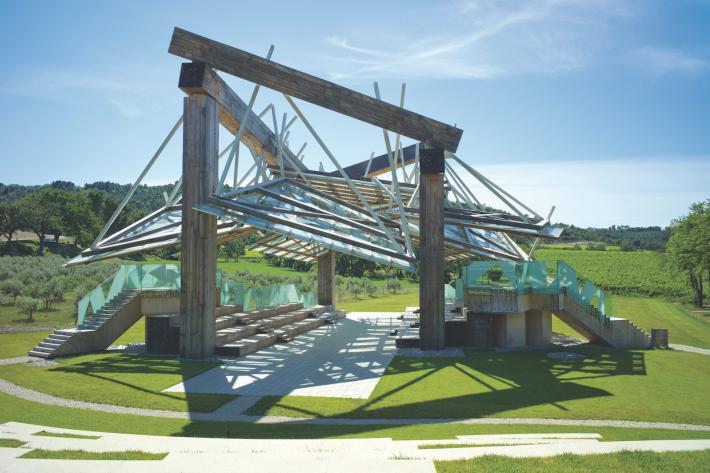
Frank O. Gehry, Pavillon de Musique (Intérieur), 2008.
Provencal winery Château La Coste is home to the Tadao Ando Art Centre, a gleaming structure made of concrete and glass that seems submerged in an infinity pool. Yet the Art Centre houses only a small part of the estate’s vast exhibition spaces and art holdings. Château La Coste’s extraordinary collection includes works of landscape art, architectural installations, and site-specific sculptures by Alexander Calder, Renzo Piano, Louise Bourgeois, Tracey Emin, Andy Goldsworthy, Richard Serra, and Ai Weiwei, among many others.
These artists are invited to design minimally-invasive, freestanding spaces, some of which extend into the sky or below ground, and many of which contain even more works of art. Just north of Aix-en-Provence, the entire property is a remarkable testament to how holistically art, sweeping landscape, contemporary art, and wine can complement each other.
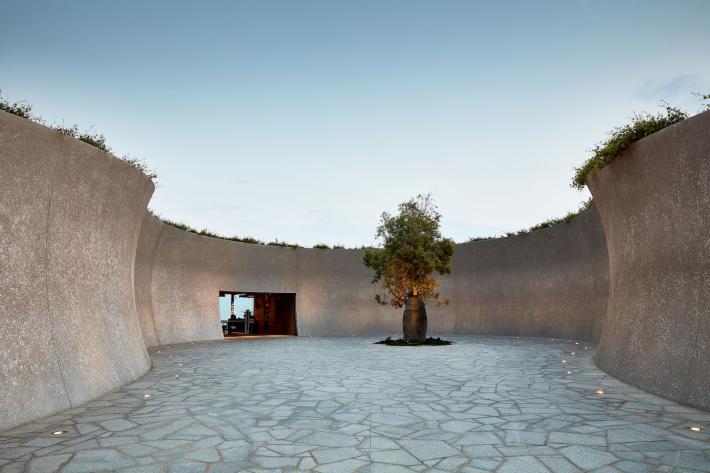
Pt. Leo Estate. Evening, December 2019.
At Point Leo Estate, visitors to the winery and restaurant are encouraged to explore the walking trails that wind through the property’s sixteen-acre sculpture park. Arranged throughout are more than sixty large-scale sculptures by Australian and international artists such as Antony Gormley, Jaume Plensa, and Inge King. All accessible by foot, the sculptures are set against clear vistas of the Mornington Peninsula and Phillip Island. Some of the pieces enhance the views while others create challenging juxtapositions between their sharp lines and the sweeping vineyards beyond. Taken together, Point Leo’s holdings are immersive and expansive. The Estate plans to keep acquiring new additions, expanding the purview of this dynamic outdoor gallery.
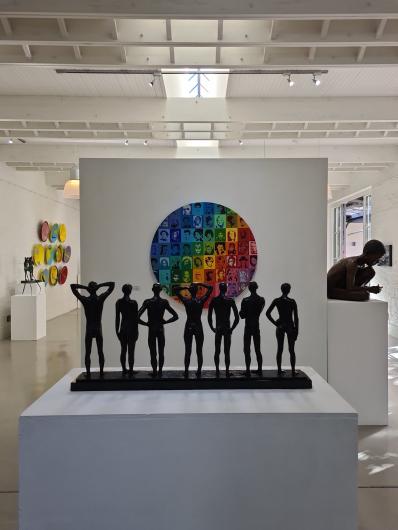
The Gallery at Grande Provence.
The Gallery at Grande Provence Heritage Wine Estate—a picturesque and sprawling hotel, restaurant, and winery—in South Africa’s Western Cape wine region is a bright and exciting space showcasing the work of contemporary South African artists in a variety of media. Beyond the Gallery’s walls, the gardens at this forty-seven-acre estate also feature large-scale South African sculptural works that enhance the manicured property and views of the surrounding mountains beyond. The Gallery’s rotating exhibitions shed light on emerging artists. The collection, curated by Pieter Lategan and managed by Jean-Marié Olivier, maintains works by more established makers, rounding out a diverse and multifaceted approach to local art.

Andy Goldsworthy, Earth and Snow (on walls), 1995 and Rock Pools, 2000, and Surface Tension (on floor), 1993.
Winemaker Donald Hess began collecting art slowly. Today, what was initially his hobby has grown into a robust collection that has cemented the Hess Persson winery firmly on the modern and contemporary art map. The property is seven miles from Highway 29, near Napa, but far removed from the region’s many neighboring wineries. The remote location and Collection are not the only elements that distinguish Hess Persson from the rest of the wine industry: their ethos runs counter to the prevalent belief that consumers need knowledge and training to truly enjoy art and wine.
The Persson family believes strongly in removing the pretension and barriers to access that have long plagued both worlds. Here, the two are made accessible to all visitors. The Perssons and their staff approach their offerings much like Donald did in his initial foray into art: with open-mindedness, a keen desire to learn, and a commitment to leaving elitism at the door.
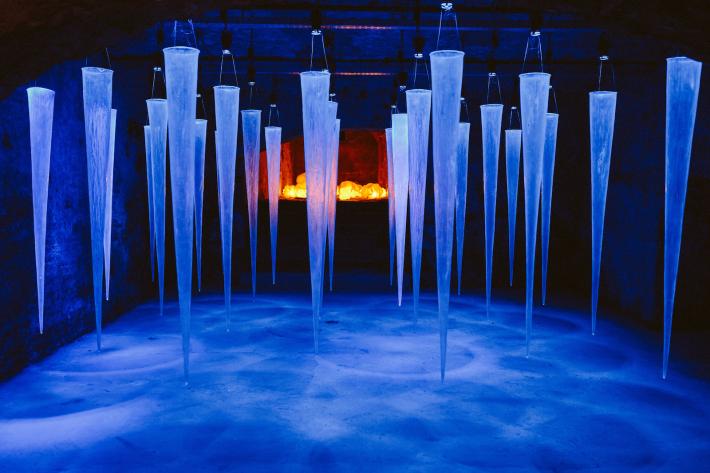
Torben Back.
Georg Müller is a minimal-intervention winery situated along the banks of the Rhein River, southwest of Frankfurt. The winery dates back to 1882, and since 2004, art and wine have been treated as symbiotic here. Georg Müller’s gallery is housed in a large, cavernous, 260-year-old wine cellar. The cellar’s dim, pointed lighting, low ceilings, and deeply-curved stone walls make for intimate and dramatic viewing, but the gallery is spacious enough to host large installations and rotating exhibitions from international contemporary artists such as Kazuo Katase, José de Guimarães, and Nina Stölting. In an effort to create truly multisensory experiences for visitors, Georg Müller pride themselves on designing tastings that complement the current exhibitions on display.

The d'Arengberg Cube.
D’Arenberg, in the renowned wine region of McLaren Vale in South Australia, is home to one of the most striking and unusual structures one might find at a wine estate. The d’Arenberg Cube is a five-story building that resembles a Rubik’s cube, with each level perched atop the one below it at a sharp angle. Inside, the Cube hosts the Alternate Realities Museum, with its rotating art installations and interactive, multisensory exhibits about winemaking.
On the lawn below, there are surrealistic sculptures that seem to spill out from the museum space. The Cube’s quirky interior also includes a restaurant and invites visitors to experience d’Arenberg’s wine amid colorful furnishings and design details, all surrounded by sweeping views of the vast property.
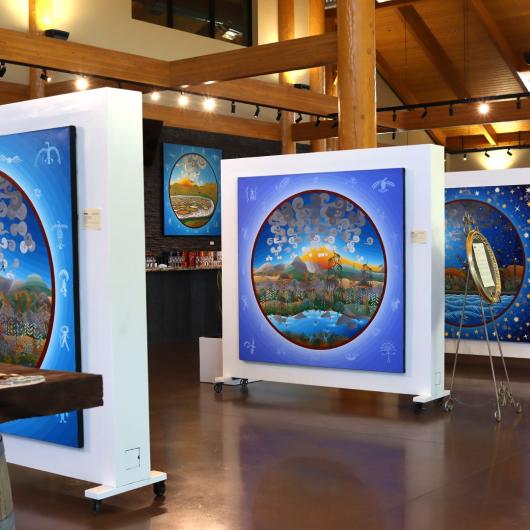
National Indigenous Day at Grizzli Winery.
Located in British Columbia’s preeminent Okanagan Valley wine region, Grizzli Winery is dedicated to showing the works of contemporary Canadian artists, many of whom are Okanagan locals, in its welcoming gallery space. Grizzli focuses much of its winemaking efforts on fruit and ice wines, drawing in visitors looking for a different wine tasting experience in an area saturated with wineries.
Like its plantings and vast tasting room, Grizzli’s rotating exhibitions and regularly-scheduled events—including live music and pop-up markets—emphasize a strong connection to the surrounding region and community.

Omaha Bay Vineyard. Lolamedia.
Omaha Bay Vineyard and Gallery hosts a small gallery space in their underground wine cave. Situated on the Tawharanui Peninsula on New Zealand’s North Island, the space features work in a variety of media made by contemporary New Zealand artists all local to this area north of Auckland.
The gallery itself is intimate, with warm lighting, a curved ceiling, and glimpses of the dramatic property through the open doors. Owners Bev and Hegman opened Omaha Bay in 2008, seeking to develop a space that could bring together sweeping views of Little Barrier Island with changing exhibits and a broad offering of wines.
Rachel Ozerkevich
Rachel Ozerkevich holds a PhD in Art History from the University of North Carolina at Chapel Hill. She's an art historian, writer, educator, and researcher currently based in eastern Washington State. Her areas of expertise lie in early illustrated magazines, sports subjects, interdisciplinary arts practices, contemporary indigenous art, and European and Canadian modernism.























